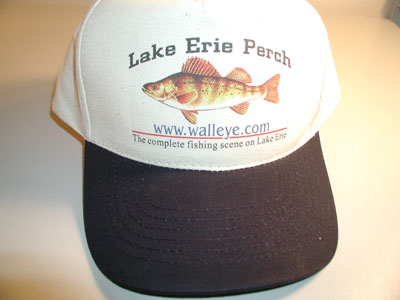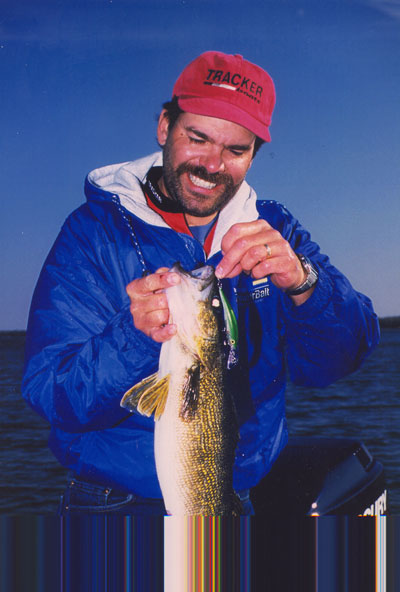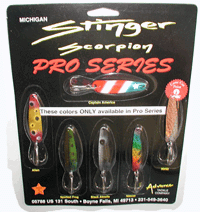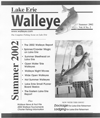|

Scorpion Stinger Spoons

Lake Erie Fishing
Maps

The Official Walleye.com
Lake Erie Walleye
Fishing Hat

NEW, Lake Erie
Perch Hats
|
Lay it on the Line
A look back on the 2003 Tournament
Season
By Gary Parsons and Keith Kavajecz
Every year about this time it’s nice to look back on the past season and
think about all the walleyes we’ve caught. Some years the season will be
remembered for the big one that made it to the net, while another year may
be remembered as the year the big one got away. It may be that it was a
"Jig" year, or maybe a "Spinner" year, because those tactics seemed to catch
the most fish.
 Then
there are those "Trolling" seasons. This past year on the PWT was a perfect
example. In five out of six qualifying tournaments, as well as the
Championship, trolling was the basis for the winning pattern. However that
doesn’t mean that every tournament was won doing the same thing. A wide
range of different trolling techniques were used, each one involving its own
unique set of components. Some involved crankbaits, while other times
spinners were the ticket. As we look back on the year, one factor seemed to
be truly different in each case … the line. For every trolling scenario we
faced this season, the choice of line used (or combination of lines) played
a key role in ultimately making the technique successful. Then
there are those "Trolling" seasons. This past year on the PWT was a perfect
example. In five out of six qualifying tournaments, as well as the
Championship, trolling was the basis for the winning pattern. However that
doesn’t mean that every tournament was won doing the same thing. A wide
range of different trolling techniques were used, each one involving its own
unique set of components. Some involved crankbaits, while other times
spinners were the ticket. As we look back on the year, one factor seemed to
be truly different in each case … the line. For every trolling scenario we
faced this season, the choice of line used (or combination of lines) played
a key role in ultimately making the technique successful.
Mid April … Lake Erie’s Western Basin. Over the past several years this
has become the walleye trolling capital of the world, and for good reason.
So much water and so many huge walleyes. This time of year meant we’d be
dealing primarily with post spawn fish that were just moving off the reefs
and into the basins. The set-up here was really about as basic as it gets …
Down Deep Husky Jerks on 10 pound test Trilene XT trolled behind Off Shore
boards. The straight mono gave the presentation just the right amount of
"stretch" to take battling these big fish, while still allowing the baits to
easily reach the depths needed to target the most fish. The added abrasion
resistance of XT makes it a good line when utilizing planer boards, because
it holds up well from any wear that it would receive from the releases.
Next stop on the trail lead us to the ever popular Lake of the Woods on
the Minnesota/Canada border. While there were several patterns used to catch
walleyes in this "late May" event, trolling worked well for us. This time we
found walleyes on shallow main lake breaks in 7 to 12 feet. Trolling #5 Shad
Raps and Tail Dancers on 10/4 FireLine, enabled us to place the small cranks
near bottom to as deep as 10 feet. Once we began targeting fish in 12 feet,
we added another element … lead core line. This was virtually the same
set-up Keith used to win the 2002 PWT Championship … a reel spooled with
lead core, and a 10 to 15 foot leader of FireLine. The rigging allows for a
"no-stretch" connection from the rod tip to the lure, so feeling the bait
tick along the bottom is effortless. If the lure happens to pick up a bit of
debris and stop running correctly, that too is easily detected, so that the
bait can be reeled in, cleaned off, and put back to work.
Week two in June found us plying the waters of the Mississippi River near
Bay City, Wisconsin. Two separate patterns unfolded here … contour trolling
the breaks of Lake Pepin, and "Pole-Lining" wing dams in the main current of
the river. Contour trolling was done much like we did on Lake of the Woods,
but "Pole-Lining" is a whole different technique. It’s actually a
modification of "Hand-Lining," a technique used to fish heavy current on
river systems around the country. The modification we used utilizes a short,
stout pole and a reel spooled with 30 pound test SpiderWire Stealth. The
terminal tackle end is made up of a 3-way swivel set-up with an 8 ounce
weight on the dropper line, and a leader tipped with a #9 Floating Rapala.
The rig can then be pulled up stream in heavy current, or even held in
place, like at the edge of a wing dam, by hovering in the current with the
kicker motor. The heavy test, small diameter SpiderWire Stealth is ideal
here because it allows you to work the heavy rig effectively, while the
line’s small diameter cuts water like a knife at the same time maintaining
tactile feel and sensitivity.
In early July it was back to Lake Erie, but this time we were at the east
end of the lake. It may have been the same Lake Erie, and still a trolling
bite, but the set-ups were a lot different. Big walleyes were suspended 30
to 35 feet down over 60 to 70 feet of water. Trolling that deep takes extra
weight … so we ended up running 6 colors of lead core line with a 20 foot
leader of 10# XT. The mono leader gave the set-up some shock absorption for
battling these big Erie bruisers.
Late July found us in South Dakota on Lake Oahe. Walleyes were relating
to the trees along the old river channel and a few main lake points. A lead
core set-up with a 10 foot leader of 17 lbs. test Berkley Vanish was the
ticket. The strength of the 17lbs. Vanish allowed us to yank a few more
crankbaits from the snaggy trees. We could use this heavy weight line with
no fear of spooking fish, as this line is a fluorocarbon with nearly the
same light refraction index as water. It virtually disappears from sight
under water! It was obviously the right choice for this tournament, as Gary
came out the winner, with Keith a close second.
The final PWT qualifying event was on Lake Michigan’s upper end, out of
the Bays de Noc area. Trolling open water style spinners tied on 17# Vanish
Fluorocarbon leaders was the important terminal end. Our reels were spooled
with 10# XT and weighted with Off Shore Snap Weights, and spread out on Off
Shore boards. With the water so clear, it was important to keep the weight
well ahead of the spinner, which is why the Snap Weights were so effective.
Those six qualifying tournaments all lead up to the Big Show … the PWT
Championship held in Michigan’s U.P. on the Keweenaw Waterway. This is Big
Walleye territory, as these fish move in and out from Lake Superior. The
set-up here was much the same as we used at Bay de Noc, with spinners, Snap
Weights and boards trolled on mono playing key rolls. While neither of us
won the Championship this go-around, we made a good showing.
We had a good season… finishing second and third in the overall "Angler
of the Year" seasonal standings. A testament to consistent performances
throughout the year, and "laying it on the line" so to speak, when it came
to putting together the right patterns for each event. Choosing the right
fishing line for each application was a key ingredient to our summer of
success. Mono, FireLine, Vanish Fluorocarbon, SpiderWire Stealth and lead
core … they all have a place in your walleye arsenal, even if all you ever
do is troll!
Editors Note: If you have questions or comments on this or other articles
from Gary Parsons and Keith Kavajecz, visit their website
www.thenextbite.com.
|






 Then
there are those "Trolling" seasons. This past year on the PWT was a perfect
example. In five out of six qualifying tournaments, as well as the
Championship, trolling was the basis for the winning pattern. However that
doesn’t mean that every tournament was won doing the same thing. A wide
range of different trolling techniques were used, each one involving its own
unique set of components. Some involved crankbaits, while other times
spinners were the ticket. As we look back on the year, one factor seemed to
be truly different in each case … the line. For every trolling scenario we
faced this season, the choice of line used (or combination of lines) played
a key role in ultimately making the technique successful.
Then
there are those "Trolling" seasons. This past year on the PWT was a perfect
example. In five out of six qualifying tournaments, as well as the
Championship, trolling was the basis for the winning pattern. However that
doesn’t mean that every tournament was won doing the same thing. A wide
range of different trolling techniques were used, each one involving its own
unique set of components. Some involved crankbaits, while other times
spinners were the ticket. As we look back on the year, one factor seemed to
be truly different in each case … the line. For every trolling scenario we
faced this season, the choice of line used (or combination of lines) played
a key role in ultimately making the technique successful.